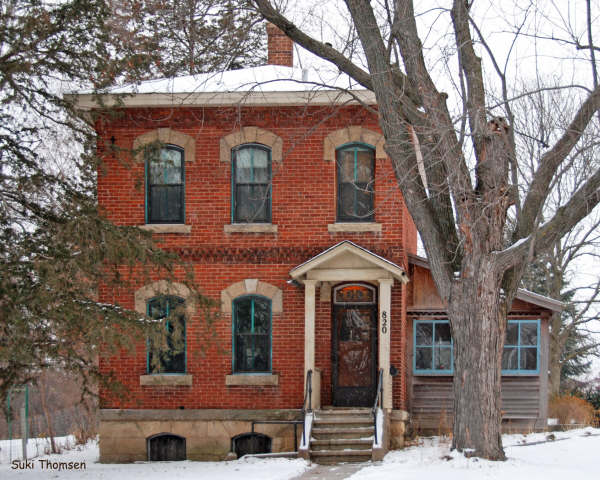Heirloom Home
William & Margaret McIntyre House
Remember that series Upstairs, Downstairs on public television a few years ago? It depicted the lives of the servants in the kitchen (downstairs) and the lives of the nobility (upstairs.) At the beginning of the 20th century, many urban English homes had the kitchen in the basement. Perhaps the mason who built this house, the Scottish-born 34-year-old William McIntyre, and his wife, Margaret, had the British Isles in mind when they designed and built this unusual house in 1884-85. To accommodate the kitchen, McIntyre raised the full basement ceiling to eight feet, seven inches, and added windows and an outside stairway to the basement directly under the front steps. (Keep in mind that at this time, most basements were no more than an eight-foot-by-eight foot root cellar accessed through a trapdoor in the floor.) On the first floor of the house, with nine feet ceilings, was the dining room, parlor, and bedroom; upstairs on the second floor were three bedrooms and a small room to be used as a nursery.
The house was built with an open colonnaded porch on the north. (The columns were found in the shed, and the original porch door is now gracing the garage.) There are no windows on the north side; the only exterior opening is the porch door, which must have opened into the dining room originally. This room was served directly by a stairway from the basement kitchen.
In the mid-1930s, that basement access to the dining room was removed and the opening floored over. A new basement stairway was tucked under the stairway to the second floor. The wall between the bedroom and living room was replaced with an archway, and another arch opened up the living room and hall. The dining room became the kitchen. At some point, the open colonnaded porch on the north side was replaced with a small frame porch.
The present owners, Robert and Nancy Goodman, have tried to keep the home’s historic look, concordant with making it livable. The old standing seam metal roof remains. The tall arched windows had been squared off to accept combination aluminum storm windows, but in the 1980s, the Goodmans had round-top storm windows (each window was a slightly different size) custom made for all the openings, including the doors. The eaves and downspouts were also removed after the cistern on the neighboring property was filled. In 1995, the utilitarian tarpaper porch was torn off and replaced with a three-season porch designed by Stillwater architect Maurice Stenerson. The following year the shed on the property was moved back and a new garage, designed by Stillwater architect, Roger Tomten, was built in its place.
In 1971, Stonebridge School bought the western three acres of this property, leaving the present site of the house about three-fourths of an acre.
The interior design of this house is unique in Stillwater and the outside details of the house are also quite unusual. While the form of this building is a typical hipped-roof, three-bay (windows) Italianate house, the decorative details are stunning. They include the rounded windows with their limestone hoods and sills and a limestone hood over the front door. The raised limestone faced basement with arched full size windows is surmounted by a wide limestone band and serves to highlight the horizontal brick filigree below the second floor.
And what happened to William McIntyre and his family after he built this home? We don’t know. He disappeared from the city in 1887, leaving behind one of Stillwater’s most striking old homes, and a testament to his masonry skills.
For other brick houses in Stillwater, see 504 Mulberry St. N., 320 Holcombe St. S.
Source(s): Information complied by Donald Empson, Empson Archives on 1/22/2009. The information in this essay was provided me by the present owners, Bob and Nancy Goodman who have owned the house since 1968. Both are superb local historians whose research and writing have made substantial contributions to the history of Stillwater and Washington County. McIntyre is listed in the 1880 Census under the name McAndrews.
Washington County Parcel Identification Number (PIN): 2803020220030
Common Property Name: William & Margaret McIntyre House
State Historic Preservation Office Inventory Number: WA-SWC-1725
Construction Date: 1884
Builder: McIntyre, William
Architectural Style: Italianate
